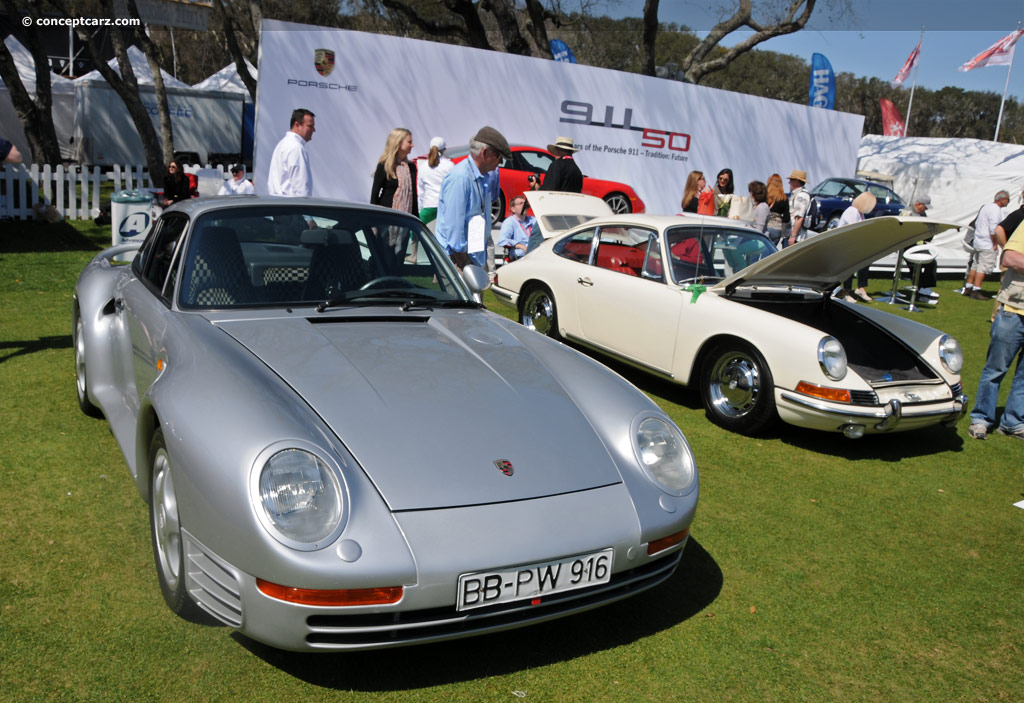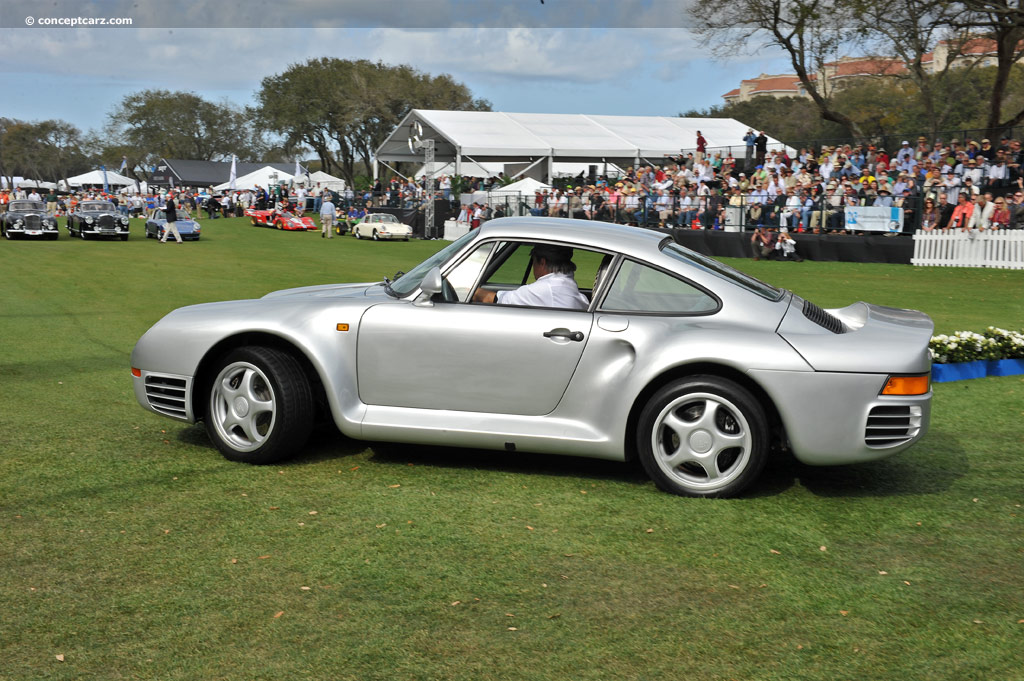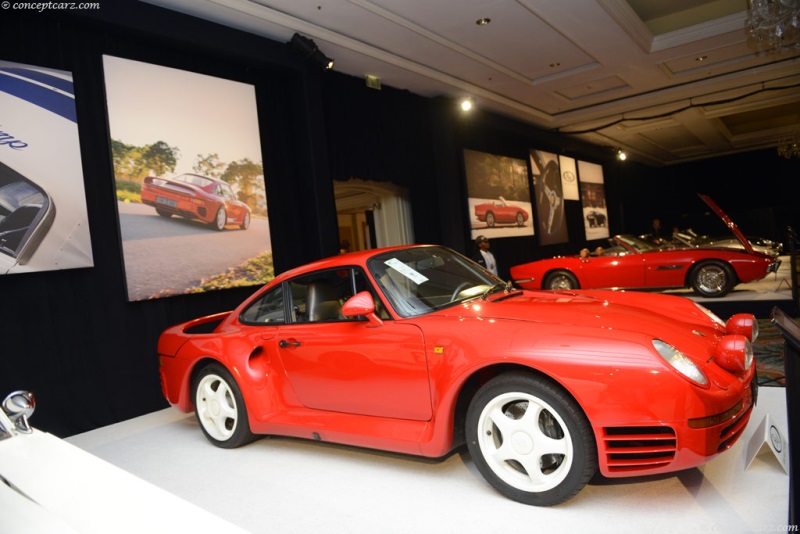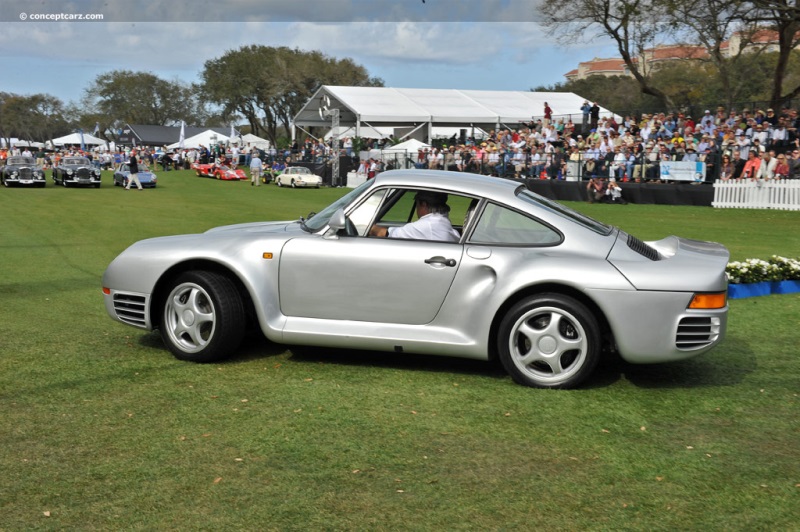The Porsche 959 represents the company's relentless pursuit of perfection and its ongoing desire to push the envelope in terms of technology and performance. It was conceived in a 1981 meeting between Porsche chief engineer Helmuth Bott and the recently hired president of the company, Peter Schutz. Bott wanted to explore the ultimate capabilities of the 911, and Schutz approved the idea and to explore its ultimate configuration in Group B competition. The automotive world was stunned in 1983 when Porsche unveiled its new 'Gruppe B' model, identified internally as the Type 961, at the Frankfurt Auto Show. It was endowed with a twin-turbocharged engine, all-wheel drive, and an innovative composite-over-steel body and chassis platform. This new machine, unmistakably a member of the 911 family, was to be the German automaker's entry into the cutting edge FIA Group B international rally championship arena, where the only rule was that there were no rules.The no-limit policy of Group B competition encouraged many automakers to create incredibly potent and extremely fast vehicles, with homologation requiring at least 200 street-legal examples of which these rally specials could be based. Following several serious accidents, the FIA abruptly canceled Group B, leaving manufacturers like Porsche 'high and dry.' Production of the homologated road cars was already underway and Porsche found itself in a dire financial situation. They had invested significantly in tooling and research, and the company's board of directors had no alternatives but to continue with production and hope to sell these 200 mph road cars to well-heeled customers. In the end, management had nothing to worry about as buyers lined up to place deposits on the Type 959.The Type 959 rested on the same 89.4-inch wheelbase, stamped steel chassis as the 911 Carrera and the cabin's center section, including its interior, was nearly identical to its 911 sibling. Much of the bodyshell was comprised of fiberglass-reinforced Kevlar, with the nose section being molded of polyurethane, and the front trunk lid and doors from aluminum. The elegant shape and aerodynamic design were formed from extensive wind tunnel studies and testing, achieving a near-zero body lift and low drag coefficient of 0.31. Ducting and venting in the nose funneled cool air to the front brakes and oil radiator. In the back, the body was greatly extended, widened, and ventilated, and topped with a full-width rear wing. The race-proven 'boxer' six was rear-mounted, with air-cooled cylinders and four-valve, water-cooled cylinder heads. The engine, with its 2.85-liter displacement size, was similar to those of the 'Moby Dick' IMSA GT coupe and Porsche's Indy open-wheel project. With the help of asymmetrical turbochargers, each of them intercooled, provided 450 horsepower at 6,500 RPM. A small turbocharger spun up almost from idle and delivered low-end boost. The second exhaust-driven turbine was engaged at 4,500 RPM. Porsche's Porsche-Steur-Kupplung (PSK) system allowed the driver to vary the 370 foot-pounds of torque between the rear and front axles. As much as 80 percent could be sent to the rear under hard acceleration, all managed electronically. Power was fed to all four wheels via a specially designed Borg-Warner six-speed transmission, which included an extremely low first gear for use in the off-road situations the Type 961 rally car might encounter.Stopping was handled by large power-assisted, ventilated disc brakes with ABS. The suspension was race-derived, with double-wishbones at each corner, coil springs, and double shocks that could be adjusted by the turn of a knob from the driver's seat. Damping and ride height were electronically adjustable, and the wheels included one of the first automatic pressure-monitoring systems. The special 17-inch lightweight magnesium alloy wheels were wrapped with model-specific run-flat tires created specifically for the 959. The earliest group of development cars were the 'F-Series' prototype, built prior to the 'V-Series' production cars and the 'N-Series' pilot vehicles. Porsche built twelve F-Series prototypes and all are discernable from each other. The third prototype, 'F3', was the first to receive air vents in the front and rear wheel housings, and intake holes behind the doors. Other 'F-Series' cars were used by engineers to various systems, interior configurations, design features, and configurations. Most of the prototype vehicles owned by Porsche were destroyed at the end of their testing period. F6, F7, and F9 were saved by Porsche importer and dealer Vasek Polak, under the premise that they would be fully restored, rebuilt, and converted to production specification to be sold as a customer car. Polak refused and as a result, Porsche required that the cars never be sold or registered for road use unless it was fully refurbished by the factory. F7 was imported to the United States for display purposes only, where it was put on display at Polak's headquarters in 1988. The road-going version of the 959 was introduced in 1985 at the Frankfurt Motor Show as a 1986 model. Numerous issues, however, delayed production by more than a year. First customer deliveries of the 959 street variant began in 1987 with an MSRP of approximately US$225,000 each. Two levels of trim were offered, including 'Sport' and 'Komfort.' The 'Komfort' models were built with a broad array of cockpit amenities, including air conditioning and full leather trim, while the 'Sport' models were outfitted with more track-focused trim. The 959 'Sport' was equipped with larger turbochargers that brought horsepower to 508 bhp. Twenty-nine Porsche 959 S examples were built. 
Coupe
Chassis #: WPOZZZ93ZFS010063
Engine #: 65F00044
View info and history
Auction entries : 1Production of the Porsche 959 ended in 1988 with 292 examples built. Including the 37 prototypes and pre-production models, a total of 337 cars were built. Eight additional cars were built by Porsche in 1992 and 1993 using spare parts from the inventory. All eight examples were 'Komfort' models with four finished in silver and four in red. Prior to 1999, the 959 was not street legal in the United States, and it is not known how many were imported illegally via the 'grey market' during the late 1980s as showpieces. In 1999, they were granted entry into the United States when the 'Show or Display' law was passed but they were never certified by the National Highway Traffic Safety Administration for street use in the U.S. as Porsche did not provide the U.S. Department of Transporation with four cars required for crash testing. To comply with emissions standards applicable in 1987, the 959 could be fitted with a catalytic converter and a re-programmed computer, allowing it to pass emissions testing.
by Daniel Vaughan | Aug 2021

Coupe
Chassis #: WPOZZZ93ZFS010063
Engine #: 65F00044
View info and history
Auction entries : 1
by Daniel Vaughan | Aug 2021
Related Reading : Porsche Type 959 History
In 1981, the development of the 959 began. Helmut Bott, the head engineer at Porsche, wanted to create a sports car based on the 911 that would take their product to the next level in performance, technology, and design. He began by collaborating with Peter Schutz, the Managing Director at Porsche, about his ideas. The ideas proposed were to continue with the rear engine configuration, examine the....
Continue Reading >>
Continue Reading >>
Similar Vehicles
Similar Automakers
1986 Porsche 959 Vehicle Profiles
Recent Vehicle Additions
Performance and Specification Comparison
Type 959 Specification Comparison by Year
Year
Production
Wheelbase
Engine
Prices
Related Automotive News

ALL-NEW 2015 ALFA ROMEO 4C SPIDER PRICING ANNOUNCED
All-new 2015 Alfa Romeo 4C Spider Delivers Race-inspired Performance, Advanced Technologies, Seductive Italian Style, and Now an Even More Exhilarating Driving Experience With Open-air Freedom
All-new Alfa Romeo 4C Spiders open-air performance ****...

ALL-NEW FORD FOCUS RS MAKES GLOBAL AUTO SHOW DEBUT; PIONEERS INNOVATIVE AWD AND PERFORMANCE TECHNOLOGIES
Fords all-new Focus RS makes global show debut in Geneva introduces advanced performance technologies to deliver the ultimate fun-to-drive experience
Third-generation Focus RS pioneers innovative Ford Performance All-Wheel-Drive with Dynamic Torq...

World-premiere: All-new 2015 Alfa Romeo 4C Spider Delivers Race-inspired Performance, Advanced Technologies, Seductive Italian Style, and now an Even More Exhilarating Driving Experience With Open-air Freedom
Production version of the all-new 2015 Alfa Romeo 4C Spider, revealed at the 2015 North American International Auto Show, will arrive at dealerships this summer All-new 2015 Alfa Romeo 4C Spiders open-air performance cockpit and mid-engine propo...

VOLKSWAGEN GTI ROADSTER MAKES NORTH AMERICAN DEBUT AT THE LOS ANGELES INTERNATIONAL AUTO SHOW
Spectacular concept car blurs the boundaries between the virtual and real worlds
HerndonLos Angeles — Volkswagen will show the spectacular GTI Roadster concept car in North America for the first time at the Los Angeles International Au...
MODEL YEAR 2015: NEW GOLF FAMILY, REDESIGNED JETTA, AND NEW TDI® CLEAN DIESEL ENGINE HEAD THE CHANGES
In a busy year, Volkswagen will also add a new Golf SportWagen, an all-new Golf R, a redesigned Touareg SUV, and the companys first U.S.-market EV, the e-Golf
All-new Golf is bigger, lighter, and more fuel-efficient than the previous model,...




























